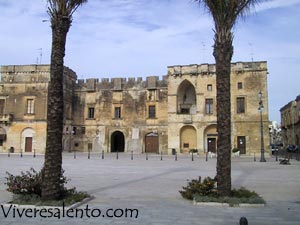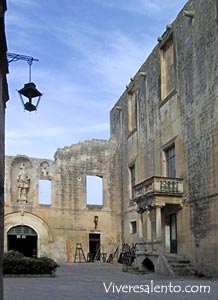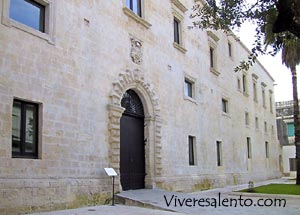|
|

| Inhabitants's name: Cavallinesi |
The civic
coat of arms of Cavallino has a blue background with a white winged horse.
Several
 prehistoric
finds were found in Cavallino and they are now in the Sigismondo Castromediano
Museum in Lecce. We do not know the ethymology of the name ‘Cavallino’. It could
derive from the Greek name ‘kabas’ that means ‘police’ then the village could
have been a place where to pay duties. The name could derive from the Latin word
‘‘caballus’’ which means ‘horse’ then the village could have been a place where
the Roman soldiers looked after their horses. The third and last hypothesis is
that the village was founded by the Greeks together with some temples dedicated
to the God Sun. The origin of this village is then very mysterious but it
certainly was the biggest town of the Messapic period. During the excavations
that have taken place between 1964 and 1967 and later from 1974 and prehistoric
finds were found in Cavallino and they are now in the Sigismondo Castromediano
Museum in Lecce. We do not know the ethymology of the name ‘Cavallino’. It could
derive from the Greek name ‘kabas’ that means ‘police’ then the village could
have been a place where to pay duties. The name could derive from the Latin word
‘‘caballus’’ which means ‘horse’ then the village could have been a place where
the Roman soldiers looked after their horses. The third and last hypothesis is
that the village was founded by the Greeks together with some temples dedicated
to the God Sun. The origin of this village is then very mysterious but it
certainly was the biggest town of the Messapic period. During the excavations
that have taken place between 1964 and 1967 and later from 1974 and 1975, people found out that the old town was 70 hectares wide and had huge
walls. People found also several graves dating to 6th century B.C.
with bronze pots and other funeral equipment. The messapic town was completely
razed to the ground during the invasions of the Goths, Longobards and the
Saracens. The King Tancredi of Altavilla included the village in the County of
Lecce but later it became part of the Principality of Taranto with the Orsini
del Balzos. In the 15th century Nita De Noha gave the villane to
Giovanni Antonio Castromediano. They became Marquis in 1628 and Dukes in 1642
and ruled until 1806. Among the famous people of Cavallino we remember: Giuseppe
Rinaldis took his degree in Law, became a famous lawyer and president of the
Court of Lecce. Andrea d’Andrea was a priest specialized in theology. He lived
in the 17th century and wrote several books. Oronzo De Rinaldis lived
between the 16th and the 17th century and was a expert of
Oriental languages. Giovanni Ferrari lived in the 17th century and
was very good in Latin, he was also a theologian and priest. Giuseppe de
Dominicis was born in 1869 was a very good poet, wrote several works in our
dialect
1975, people found out that the old town was 70 hectares wide and had huge
walls. People found also several graves dating to 6th century B.C.
with bronze pots and other funeral equipment. The messapic town was completely
razed to the ground during the invasions of the Goths, Longobards and the
Saracens. The King Tancredi of Altavilla included the village in the County of
Lecce but later it became part of the Principality of Taranto with the Orsini
del Balzos. In the 15th century Nita De Noha gave the villane to
Giovanni Antonio Castromediano. They became Marquis in 1628 and Dukes in 1642
and ruled until 1806. Among the famous people of Cavallino we remember: Giuseppe
Rinaldis took his degree in Law, became a famous lawyer and president of the
Court of Lecce. Andrea d’Andrea was a priest specialized in theology. He lived
in the 17th century and wrote several books. Oronzo De Rinaldis lived
between the 16th and the 17th century and was a expert of
Oriental languages. Giovanni Ferrari lived in the 17th century and
was very good in Latin, he was also a theologian and priest. Giuseppe de
Dominicis was born in 1869 was a very good poet, wrote several works in our
dialect
 and
died very young when he was only 36. Sigismondo Castromediano was born in 1811
and belonged to the family who ruled the village, the Castromedianos. He was
very critical towards the Bourbons and took part to a rebellion against them in
1848 and for this reason was sentenced to 30 years imprisonment. In 1859 he run
away on a ship towards Ireland while he was waiting to be sent in America. He
came back to Italy in Turin and was helped by the King. He was elected as a
deputy in the elections of 1861 and was also counsellor of the Province of
Lecce. He wrote many autobiographical books. and
died very young when he was only 36. Sigismondo Castromediano was born in 1811
and belonged to the family who ruled the village, the Castromedianos. He was
very critical towards the Bourbons and took part to a rebellion against them in
1848 and for this reason was sentenced to 30 years imprisonment. In 1859 he run
away on a ship towards Ireland while he was waiting to be sent in America. He
came back to Italy in Turin and was helped by the King. He was elected as a
deputy in the elections of 1861 and was also counsellor of the Province of
Lecce. He wrote many autobiographical books.
|